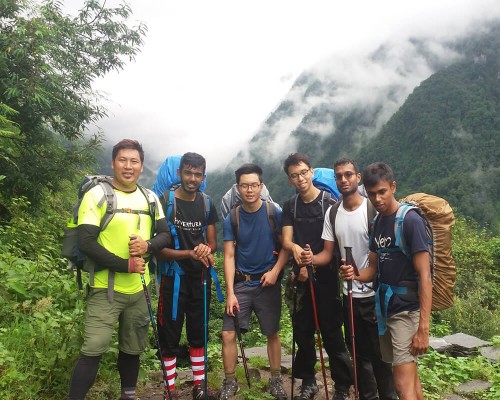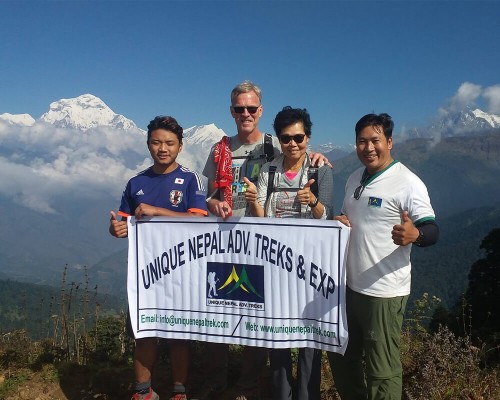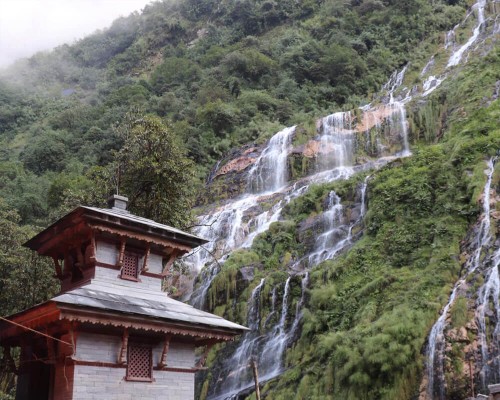Overview of Classic Annapurna Base Camp Trek
The Annapurna Base Camp Trek is a perfect 12-day journey, reaching 4130 m and showcasing Annapurna's majestic peaks. Witness Annapurna I, the 10th highest globally, and its impressive ice glacier. Known as Annapurna Sanctuary or ABC Trek, it's accessible via charming Gurung villages and suspension bridges. Explore the Ghorepani Poon Hill route for breathtaking views of Mt. Dhaulagiri, Mt. Manaslu, and more. Suitable for all ages, with customizable itineraries to fit your schedule.
The Annapurna Base Camp (Sanctuary) trek offers a classic and moderate experience, showcasing magnificent mountain views, lush nature, forests, rivers, terraced fields, and the unique lifestyle of the Gurung people. Situated in northwest Nepal, it's a naturally and culturally rich trekking route, with stunning crystal-clear mountains adding to its beauty. Our customized 12-day itinerary ensures a delightful trip, with various alternative routes leading to Annapurna base camp up to 5 days.
The Annapurna Base Camp trek starts with a 7-8-hour bus ride from Kathmandu to Pokhara or a 35-minute flight. Alternatively, you can opt for a private vehicle. After spending a night in Pokhara near the beautiful Fewa Lake, you'll drive to Nayapul the next day and begin trekking along picturesque riverbanks, passing villages like Birethanti, Hille, and Tikhedunga before reaching Ulleri, which involves a gradual ascent and two hours of steady uphill climbing.
The following day takes you to the stunning Ghorepani, walking amidst lush rhododendron forests. Early the next morning, a one-hour ascent to Poon Hill offers breathtaking views of Mt. Dhaulagiri, Annapurna, Fishtail, and more during sunrise. Continuing the trek, you'll explore villages like Ghandruk, Chhomrong, Sinuwa, Bamboo, Dovan, Deurali, MBC (Machhapuchhre Base Camp), and ABC over the next few days, surrounded by snow-capped peaks such as Annapurna I, South, Hiuchuli, Tent Peak, Annapurna III, Gangapurna, Gandarba Chuli, and Fishtail. The close-ups and scenic views are immensely gratifying and joyful.
After completing the trek at Annapurna Sanctuary, you'll retrace your steps to Chhomrong village and then visit the natural hot spring in Jhinu Danda, where you can relax and bathe in the warm pool. The following day, after a few hours of walking, you'll take a vehicle back to Pokhara. The day after, you'll return to Kathmandu for your final departure. We can customize a shorter 6-day Annapurna base camp trek from Pokhara to Pokhara according to your schedule.
Our team includes professional and dedicated guides who provide nightly briefings about the next day's program, share news and insights about Nepal, and strive to meet your needs and ensure your satisfaction. Our porters are also attentive and helpful, ensuring a comfortable trekking experience. Don't hesitate to ask your guide questions—they're eager to share more information and make your journey memorable. Our goal is to turn your dream into reality: "Come as a guest, leave as a friend."
What kind of people and culture can we explore on the ABC trek?
The trek passes through Gurung and Magar villages like Ghorepani, Ghandruk, and Chomrong, offering a glimpse into their unique traditions, language, and daily life. Most locals are farmers and lodge owners known for their warm hospitality.
What mountain views can we see on the Annapurna Base Camp trek?
You’ll enjoy stunning Himalayan views throughout the trek. Poon Hill (3,210 m) offers a famous panoramic sunrise, while Annapurna Base Camp provides dramatic close-up views of the Annapurna range.
The Mountains Viewing from Poon Hill (3210 m)
- Mt. Dhaulagiri (8167 m/26795 ft).
- Mt. Manaslu (8163 m/26782 ft)
- Annapurna-I (8091 ft)
- Annapurna-II: (7937 m/26065 ft)
- Annapurna South (7219 m/23685 ft)
- Fishtail (Machhapuchhre) (6993 m/22943 ft)
- Hiuchuli 6441m / 21132ft
- Mt Tukuche (6920 m/22704 ft)
- Mt. Nilgiri (6860 m / 22507 ft)
Breathtaking Mountain View from Annapurna Base Camp
- Annapurna-I (8091 m/26546 ft)
- Annapurna-III (7545 m/24754 ft)
- Annapurna South (7219 m/23685 ft)
- Fishtail (Machhapuchhre) (6993 m/22943 ft)
- Hiuchuli (6441 m/21132 ft)
- Tent Peak: (5695 m/18685 ft)
12-Day Annapurna Base Camp Trek - Outline Itinerary
Day 01: Arrive in Kathmandu and transfer to a tourist-standard hotel.
Day 02: Travel to Pokhara—a 30-minute flight or 7-hour drive.
Day 03: Drive to Nayapul, then trek to Ulleri (6–7 hours).
Day 04: Trek to Ghorepani (2,874 m)—approx. 6–7 hours.
Day 05: Early morning hike to Poon Hill for sunrise and Himalayan panorama, then trek to Tadapani (long morning walk, arrive by afternoon).
Day 06: Trek to Sinuwa (2,360 m) 6–7 hours.
Day 07: Trek to Deurali (3,200 m) 6–7 hours.
Day 08: Trek to Annapurna Base Camp (4,130 m), walking (5–6 hours).
Day 09: Enjoy sunrise views of Annapurna I (8,091 m), South Face, and Machapuchare (Fishtail). After breakfast, trek down through MBC, Himalaya, Dovan, and Sinuwa.
Day 10: Trek to Jhinu Danda, have lunch, then drive back to Pokhara by local jeep.
Day 11: Return to Kathmandu by flight or drive. Stay at a tourist-standard hotel.
Day 12: Final departure—drop-off by private vehicle.
5-day Short and sweet ABC Trek Pokhara to Pokhara
Day 01: Pokhara to Jhinu Bridge by jeep, then trekking to Sinuwa.
Day 02: Sinuwa to Deurali (3200 m) walking (6/7 hours).
Day 03: Deurali to ABC (4130m) walking (5/6 hours)
Day 04: After the ABC Visit, Trekking to Sinuwa (7 hours)
Day 05: Trek to Jhinu Bridge, have lunch, and drive back to Pokhara.
If you like, visit the 5-Day Annapurna Base Camp for a short time with budgeting; please feel free.
What kind of wildlife, flora, and fauna can we see on the ABC Trek?
The Annapurna region falls within the Annapurna Conservation Area, offering treks through enchanting rhododendron and pine forests that are vital for preserving wildlife and diverse flora and fauna. During the trek, you may encounter various wild animals such as yaks, monkeys, deer, mountain goats, blue sheep, wild boars, bears, snow leopards, foxes, red pandas, and a wide variety of bird species, including the national bird of Nepal, the Danphe (monal), lophophores, Kalij, and more.
Is it difficult to do the Annapurna Base Camp Trek?
The Annapurna Base Camp trek is moderate, not excessively challenging, despite reaching 4130 m/13550 ft. It's advisable to proceed at a leisurely pace. The trail is well-maintained, making it suitable for all age groups—this trek welcomes both the young and the old alike.
Do we need any entry permits to trek to Annapurna Base Camp?
Sure, you need permits to visit Annapurna Base Camp. We'll help you get them. Your guide will handle the permits during the trek, and you'll get a souvenir afterwards. The required permits are the Annapurna Conservation Area Permit (ACAP) and the Trekkers' Information Management System (TIMS) card.
- Annapurna Conservation Areas Project, Nr. 3000/-
- TIMS (Trekking Information Management System), Nr. 2000/–
- Poon Hill Entrance Permit, Nrs. 250/-
When is the best time to visit Annapurna Base Camp for trekking?
The ideal times for Annapurna Base Camp trekking are autumn (September to late December) and spring (March to May) due to clear weather, good temperatures, excellent visibility, and stunning mountain views. Winter (snowy and cold) and monsoon (rainy, cloudy, and poor visibility) are doable with proper planning for safety and success.
- Autumn Season: September, October, November, and December.
- Winter Season: late December, January, and February
- Spring Season: March, April, and May
- Monsoon Season: June, July, and August.
How Much Does the Annapurna Base Camp Trek Cost?
The Annapurna Base Camp trek costs US$725 per person for a 12-day full-board package. If you book Kathmandu and Pokhara hotels yourself, the cost is $650 each. The ABC's shortest trek is 5 to 6 days, also possible for a quicker adventure from Pokhara to Pokhara.
We need a minimum of 2 people in a group; if you are a single visitor, the cost will be slightly more. Our competitive regional rates ensure quality service and a well-organised experience.
Cost, including service packages,
- The airport picks up and drops off private vehicles.
- Kathmandu and Pokhara Hotel, 2–2 Nights. The price is as mentioned; the hotel includes or excludes
- Transportation from Kathmandu to Pokhara and return is a comfortable tourist bus, but if you would like to take a flight or private vehicle, let me know. I can arrange any of your choices' services.
- Pokhara to Nayapul, and after the end of trekking, Siwi to Pokhara transportation
- Full board meals during the 8-day trek include lunch, dinner, and breakfast.
- One guide and porters and their full board wages, such as lodging, food, transportation, salary, insurance, etc.
- Needed Permits: ACAP and TIMS
- Seasonal fruits and some snacks—cookies, bars, etc.
- First aid kit bag
Something is excluded; please have a look at our cost details. Some services are included and excluded.
















